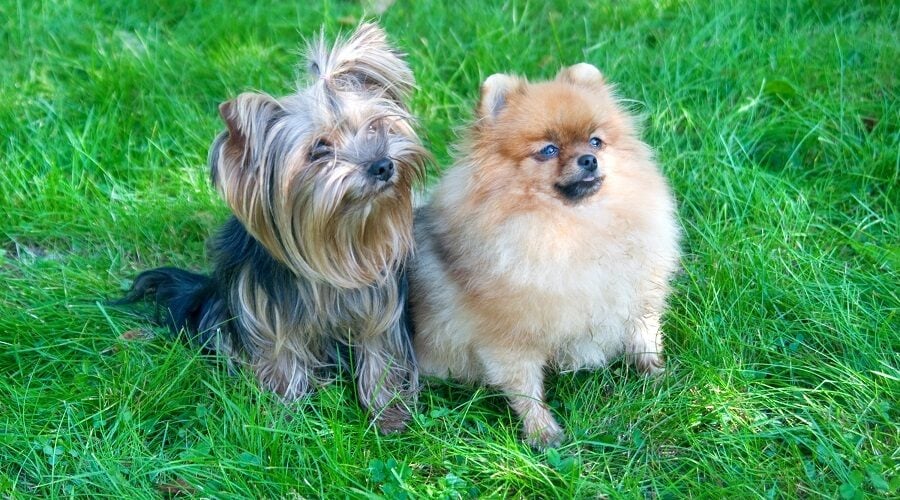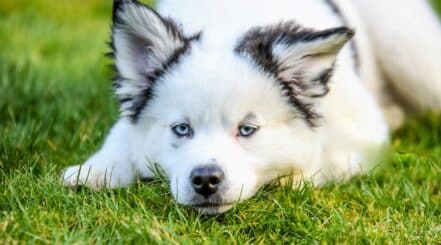The Pomeranian and the Yorkshire Terrier are very similar in many ways, and so there are only a few factors that will set these guys apart from one another.
They are similar in size, temperament, exercise, and health needs. The most significant difference between the two, aside from their appearance, is that the Yorkshire Terrier is a hypoallergenic dog, and as such he is the better breed choice for any family who has dog allergies.
In this article, the Yorkshire Terrier will be referred to by his common nickname, the Yorkie. So, let us begin the comparison to see which breed may be better for you and your family.
Breed Comparison
Pomeranian
- Height 6-7 Inches
- Weight 3-7 Pounds
- Temperament Inquisitive, Bold, Lively
- Energy Average
- Health Average
- Lifespan 12-16 Years
- Price $1,000 and Up
Yorkshire Terrier
- Height 7-8 Inches
- Weight 2-7 Pounds
- Temperament Affectionate, Sprightly, Dependent
- Energy Average
- Health Average
- Lifespan 11-15 Years
- Price $800 and Up
Breed History
Pomeranian

Pomerania, which is now known as northeastern Germany and west Poland, is where the Pomeranian originated and got its name. The Pomeranian is closely related to the German Spitz, and they are often compared to one another. Other relatives include the Norwegian Elkhound, the Schipperke, and the American Eskimo Dog.
Poms have been a popular breed for a long time, having famous owners such as Mozart, Isaac Newton, and Michelangelo. The AKC has ranked the Pomeranian as the 23rd most popular dog in America. However, the Pom was not an immediate sensation. In 1761, the Princess of Pomerania married an English Prince and took her Pomeranians with her to her new country, where they were not vastly welcomed.
It wasn’t until 1888 when Queen Victoria of England fell in love with Poms she met on a trip to Italy. In that same year, the first Pomeranian was initially entered into the American Kennel Club’s (AKC) studbook. The Pomeranian is a favorite among those who love smaller dogs, live in small living spaces, and have active lifestyles.
Yorkshire Terrier

During the mid-1800s, Yorkies were bred for the purpose of extermination and rat-hunting in England. Various breeds from Britain were used to produce them, and some ended up becoming extinct. Owners brought these dogs to northern Yorkshire and Lancashire counties of England mostly as Scotch Terriers, which refers to the Terriers of Scotland and not the same as today’s Scottish Terriers.
Yorkies were mainly owned by weavers because they were viewed as working-class dogs. The silky coat of the Yorkies made them a very suitable pet for weavers. It was often said that their coats were the ‘ultimate product of the looms’ of their owners.
As a result of their small size and quick movement, they could fit into crevices and catch rats and other vermin. In 1886, the English Kennel Club recognized the breed, which made Yorkies suddenly very fashionable. The size of the dogs was diminished due to their popularity as lapdogs for Victorian ladies. These dogs are now well known as lapdogs and show dogs.
The Yorkie is slightly more popular than the Pom as the 10th most popular dog and is often compared to other terrier breeds.
Appearance

The Pomeranian and the Yorkie, despite their almost identical size, look entirely different. The Pomeranian has a fuzzy exterior thanks to his thick and fluffy fur, and he takes on various singular shades. He can be both darker in color or lighter.
The Yorkie, however, has straight and silky locks that fall to the floor. He has a dark color, either black or a diluted blue, with either gold or tan markings, His hair is often cut short for those who either prefer the look, or those who can’t commit to the daily grooming routine.
The Pomeranian and the Yorkie are both a part of the toy group, so it is safe to assume you are seeking a smaller pup with a big personality. The Yorkie has a teacup version as well. If it is a small canine package that you are after, then there are also plenty of other small dogs in the other groups, so be sure to check out the AKC ‘smallest dog breed’ page that may offer you some other alternative breeds.
Although their differing appearance has no bearing on their ability to make a great family pet, this is one of the main factors that guide prospective owners to choose one breed, simply because they favor one look over the other.
Temperament

The Pomeranian and the Yorkie both have sweet temperaments, but with a feisty and energetic twist. The Pomeranian is much more independent and more confident than the Yorkie.
The Pomeranian also loves the sound of his voice much more than the Yorkie, so, if you live in a noise-restricted household then the Yorkie is probably the better breed for your circumstances. The Yorkie, being a Terrier, is a bit more chilled and laid back, but he also knows how to have just as much fun.
They are adorable balls of energy and will keep you and your family entertained for hours. They both enjoy a good romp around the yard, and you can rest assured that because of their tiny size they probably aren’t going to ruin your turf, unlike a larger dog.
Overall, their temperament is similar in that they both have delightful and fun personalities. If you are seeking a more independent dog then the Pomeranian is probably the better choice for you, whereas if you are after a more easy-going pup then the Yorkie fits the bill.
Exercise

Both the Pomeranian and the Yorkie are medium energy dogs, who both need up to 30 minutes of exercise every day. They also need mental stimulation in between their daily exercise which can take the form of a good romp around the yard or play with their toys.
While they are both partial to an afternoon snooze with their humans, they will not appreciate being kept indoors all day as a full-time lapdog, so do not make this mistake like many others have done previously. Both of these guys are popular with city dwellers due to their small size and moderately low energy levels, and as such, they are well suited to apartment life. Of course, they are suited to large estates also, but you may just lose them!
Overall, the Pomeranian and the Yorkie need the same amount of exercise. If you are a family that can provide up to 30 minutes of exercise every day, then they will both be suited to you.
Training

The Pomeranian and the Yorkie are independent and stubborn, and if they are not in the mood to listen to you then they simply will not. Because of their independent traits they can be difficult to train compared to the average pup.
Some owners suggest that the Yorkie may be slightly easier to train because he is a Terrier, and therefore he is more likely to want to please his master and he will pick up commands quicker. On the other hand, there are some owners who argue that he is just as stubborn as the Pomeranian. Ultimately, the key here is to train them as early as you can, be consistent, and keep training sessions short and sweet, just like these guys!
Overall, the Pomeranian and the Yorkie are independent creatures, and as such, they can be tough to train. The entire family should be consistent with their training and you should not expect a fully obedient dog 100% of the time. When you leash train, make sure you get a harness specifically made for a small dog to make sure they get used to it right away.
The Pomeranian and the Yorkie are gentle creatures that enjoy the company of small children. The only issue here is that younger children may not know how to handle these tiny pups, and this can end in injury to the small dog. Many people say that they are not suitable for young children, but this is a personal choice, if you think that your child understands how to handle a small dog properly, then they will both make for great companions for children.
They also both get on well with other pets as long as they are socialized properly at a young age. If they miss this crucial training as a pup then they are known to be fearsome of other dogs, particularly larger dogs, and they will exhibit fear of aggression barking. Not only is this undesirable behavior, but it can also land them in hot water if they pick on the wrong dog.
Health

The Pomeranian and the Yorkie are generally healthy dogs, with the Pomeranian living, on average, one year more than the Yorkie. They are both prone to similar health issues, and their parents should both be tested for Luxating Patella and various eye issues.
The Pomeranian should also undergo a cardiac exam. As both the Pomeranian and the Yorkie are small dogs with small mouths, they will also need their teeth brushed on a regular basis more so than larger dogs.
Overall, both the Pomeranian and the Yorkie are healthy dogs that are prone to suffering similar ‘small dog’ health issues, and while the Pomeranian has to be examined for additional cardiac problems, he tends to live slightly longer than the Yorkie.
Nutrition

Poms and Yorkies both flourish on high-quality kibble that is appropriate for the dog’s age. Dog food formulated for the life stage ensures the pup, adult, and senior all get the right nutrients their bodies need at the time.
Even though Yorkies are some of the smallest dogs in the world, they still need nutrients similar to that of larger dogs. Yorkies especially need a dry kibble to help fight plaque. This kibble should be high in nutrients such as omega 3 and 6 fatty acids to help keep its coat shiny, as well as healthy carbohydrates to keep him energized.
Pomeranians also have specific nutritional needs similar to the Yorke and other toy dogs. Poms need high-quality kibble that is formulated for its life stage. Dog food that is high in protein with an optimum blend of vitamins, minerals, and antioxidants is recommended.
On average, both breeds will eat between 1/2 and 1 1/2 cups of food each day. This, of course, is completely dependent on the particular dog’s age, weight, and activity level. Generally speaking, the Pomeranian may eat more than the Yorkie, but it is not very significant.
Grooming

Both the Pomeranian and the Yorkie require certain care when it comes to their grooming routine. The Pomeranian has a fluffy exterior that requires daily grooming, and the Yorkie’s coat traditionally is long and silky, which again requires daily brushing to ensure that it is kept healthy. Of course, if your Yorkie has a regular trim at the hairdressers and does not have the traditional long hair, then he will require much less grooming than the Pomeranian.
The Pomeranian has a double coat that sheds, and as such he is not a great pet for anyone who has dog allergies. The Yorkie, however, despite his long hair, does not shed and is considered a hypoallergenic dog by the AKC, which is great news if anyone in your family has dog allergies.
Puppy Prices

The cost of the Pomeranian starts from $1,000 and the cost of a Yorkie starts from $800. The Pomeranian and the Yorkie eat the same amount of food per day, so the cost of their nutritional needs is also the same in terms of pricing.
You would be wise to remember that many unscrupulous breeders, or puppy mills, churn out toy pups because they are in fashion, and they will cut corners on health checks and the very important first stages of their life. While the cheap price might seem appealing, you are risking years of illness and vets bills, and of course a very unhappy pup and unhappy family life. As with any dog breed, buy your pup from a reputable breeder as it is not worth the risk!
Pomeranian puppies registered with the AKC can be found here, and Yorkie puppies registered with the AKC can be found here.
Final Thoughts
Overall, the Pomeranian and the Yorkie are similar toy pups who are small, sprightly, and seriously cute! They are the same size, they have the same temperament and they almost have the same grooming and health issues to be concerned about.
The few differences between the two breeds are that the Pomeranian is more independent and barkier, whereas the Yorkie is more laid back than diva. The Yorkie is a hypoallergenic dog which is great for families with dog allergies, whereas the Pomeranian is not. Although their size is almost identical, they do look completely different.






I want Pomeranian teacup girl
Good article, thank you
Yorkshire Terrier are the Best companions.Sweet andl loving.My grandpup is 13 years old. Love her so much.
Thank you for all of your great information! How can I find one that is young, 2-4yrs old? Everyone wants a puppy now, right?
I wish there was a source to go to for the “young Pom/Yorkie”. Now you have me interested in the Porkie!! lol!
Maybe some elderly people who are moving in with their family/home now due to covid? I am sure they would like their babies to have a nice home?
Thank you again! Any info you might have – I will take it! Like many of us, I can’t afford a $1k + doggie. I wish I could
find that little itty bitty pom out there that is looking for me!
Happy New year! Best Wishes for 2021!
Hi DJ! I would recommend looking at local rescues. Rescue costs to adopt can range between $200, and $500. Definitely cheaper than a smaller puppy, and you’ll still likely be able to get a purebred pup. Some of them may have some baggage (we own 2 rescue dogs) but if you can work past that, you’ll both save a life, and reduce your overall dog ownership costs.
We actually have a page dedicated to just mixed Poms you should check out if you’d like to know what some of them may look like. Good luck in your search and thanks for commenting!